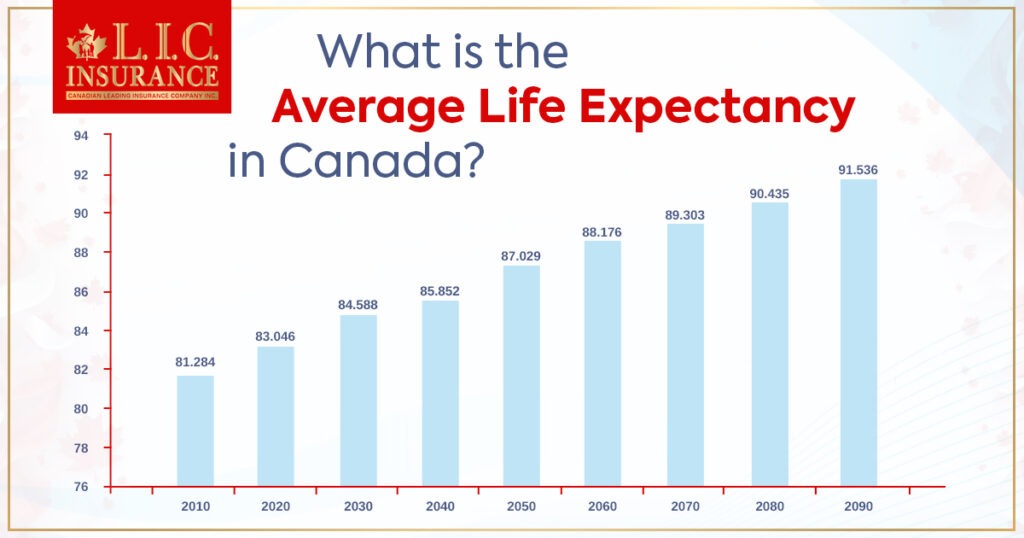- What Is The Average Life Expectancy In Canada?
- Let’s Understand Life Expectancy
- The Historical Trend Of Life Expectancy In Canada
- Regional Variations In Life Expectancy
- Challenges And Future Trends
- What’s The Most Common Cause Of Death In Canada?
- Why Is Canada’s Life Expectancy So High?
- Is Wealth Related To Life Expectancy In Canada?
- What Does Life Expectancy In Canada Have To Do With Life Insurance?

Life expectancy significantly indicates a nation’s overall health and well-being. It reflects the average number of years a person can expect to live based on current mortality rates. In Canada, a country known for its high quality of life, universal healthcare system, and diverse population, life expectancy has steadily increased over the years. This comprehensive guide will delve into the factors influencing life expectancy in Canada, its historical trends, and the various demographic and health-related aspects that contribute to the nation’s impressive average life expectancy.
Let’s Understand Life Expectancy
Life expectancy is a statistical measure used to estimate the average number of years a person born in a specific year can expect to live, assuming that current mortality rates remain constant throughout their lifetime. It is typically calculated based on data related to mortality, age-specific death rates, and various demographic factors.
The Historical Trend of Life Expectancy in Canada
Life expectancy in Canada has shown a consistent upward trend over the past century, thanks to improvements in healthcare, sanitation, nutrition, and living conditions. Key milestones in Canada’s life expectancy history include:
- Universal Healthcare System: Canada’s publicly funded healthcare system ensures that citizens and residents have access to necessary medical services without the burden of high healthcare costs. Regular medical check-ups, early disease detection, and timely treatment contribute to longer life expectancies.
- Healthier Lifestyles: Canadians have become more health-conscious, with increased awareness of the importance of regular exercise and a balanced diet. Lower smoking rates and reduced alcohol consumption have also positively impacted overall health.
- Improvements in Medical Technology: Advances in medical technology and pharmaceuticals have led to better treatment options and increased survival rates for various health conditions.
- Economic Prosperity: Canada’s strong economy provides citizens with the means to access healthcare services, maintain healthy lifestyles, and afford nutritious food.
- Education and Awareness: Higher levels of education and public health awareness have led to informed decisions about health and well-being.
- Social Programs: Canada’s social programs, including senior care and support for vulnerable populations, contribute to improved health outcomes and longevity.
- Low Crime Rates: Canada’s relatively low crime rates create a safe and secure environment, reducing the risk of premature death due to violence.
- Diverse and Inclusive Society: Canada’s multicultural society promotes social cohesion and inclusivity, leading to better mental and emotional health.
- Environmental Factors: Clean air, water, and a focus on environmental conservation contribute to better overall health and well-being.
Regional Variations in Life Expectancy
While Canada boasts a high average life expectancy, there are regional variations within the country. Life expectancy can vary by province, territory, and even by specific cities or communities.
Some of the key factors influencing these regional variations include:
- Critical Illness Insurance: Areas with higher levels of poverty and lower socioeconomic status tend to have lower life expectancies.
- Disability Insurance: Rural and remote areas may have limited access to healthcare services, impacting health outcomes.
- Disability Insurance: Differences in lifestyle choices, such as smoking rates and diet, can affect life expectancy.
- Disability Insurance: Some regions may face unique environmental challenges that impact health, such as air pollution or exposure to natural disasters.
Efforts are ongoing to address these regional disparities and ensure that all Canadians have the opportunity to live long and healthy lives, regardless of where they reside.
Challenges and Future Trends
While Canada’s life expectancy continues to rise, it is not without challenges:
-
Aging Population: Canada, like many developed countries, faces the challenge of an aging population. This demographic shift presents healthcare and social support challenges.
- Mental Health: Mental health issues and related challenges, such as addiction and stress, are areas where improvements are needed to maintain high life expectancies.
- Healthcare Access: Ensuring equitable access to healthcare services remains a priority, particularly in underserved regions.
- Chronic Diseases: Addressing the rise of chronic diseases, such as diabetes and heart disease, is crucial to maintaining and increasing life expectancy.
What’s the most common cause of death in Canada?
As of September 2021, the most common causes of death in Canada were generally related to chronic diseases and conditions. However, it’s important to note that the prevalence of specific causes of death can change over time due to various factors, including advances in healthcare and changes in lifestyle.
Common causes of death in Canada at that time included:
- Cancer: Cancer was one of the leading causes of death in Canada. Lung cancer, colorectal cancer, breast cancer, and prostate cancer were among the most common types.
- Heart Disease: Cardiovascular diseases, including heart disease and stroke, were significant contributors to mortality.
- Respiratory Diseases: Chronic respiratory diseases, such as chronic obstructive pulmonary disease (COPD), also play a role in causing deaths.
- Diabetes: Diabetes and its complications, including cardiovascular issues and kidney disease, were a concern.
- Accidents and Injuries: Unintentional injuries and accidents, such as motor vehicle accidents, falls, and workplace accidents, were leading causes of death, particularly among younger age groups.
- Alzheimer’s Disease and Dementia: Neurodegenerative diseases like Alzheimer’s disease were a concern, especially among the elderly population.
For this reason, Canadian LIC highly advises that Canadians purchase Critical Illness Insurance. The likelihood of developing cancer makes it unnecessary to go without a plan to safeguard your family in the event of the unexpected.
It’s essential to consult the latest data and reports from organizations such as Statistics Canada or the Canadian Institute for Health Information (CIHI) to obtain the most current information on the leading causes of death in Canada, as trends can evolve over time due to public health efforts and advancements in medical care.
Get The Best Insurance Quote From Canadian L.I.C
Call 1 844-542-4678 to speak to our advisors.

Why is Canada’s life expectancy so high?
Canada’s high life expectancy can be attributed to a combination of factors, including its healthcare system, socio-economic conditions, lifestyle, and public health efforts. Here are some key reasons why Canada has a relatively high life expectancy:
- Universal Healthcare System: Canada’s publicly funded healthcare system ensures that all citizens and permanent residents have access to necessary medical services without the burden of high healthcare costs. Regular medical check-ups, early disease detection, and timely treatment contribute to longer life expectancies.
- Access to Quality Healthcare: Canada boasts a high standard of medical care, with well-trained healthcare professionals, modern hospitals, and advanced medical technology. This access to quality healthcare services enhances the overall health of the population.
- Healthy Lifestyles: Many Canadians prioritize a healthy lifestyle, including regular exercise and a balanced diet. Lower smoking rates and reduced alcohol consumption have also contributed to better overall health.
- Advancements in Medical Technology: Advances in medical technology and pharmaceuticals have led to better treatment options and increased survival rates for various health conditions.
- Economic Prosperity: Canada’s strong economy provides citizens with the means to access healthcare services, maintain healthy lifestyles, and afford nutritious food.
- Education and Awareness: Higher levels of education and public health awareness have led to informed decisions about health and well-being.
- Social Programs: Canada’s social programs, including senior care and support for vulnerable populations, contribute to improved health outcomes and longevity.
- Low Crime Rates: Canada’s relatively low crime rates create a safe and secure environment, reducing the risk of premature death due to violence.
- Diverse and Inclusive Society: Canada’s multicultural society promotes social cohesion and inclusivity, leading to better mental and emotional health.
- Environmental Factors: Clean air, water, and a focus on environmental conservation contribute to better overall health and well-being.
Canada’s overall life expectancy is relatively high, and there can be regional variations within the country due to differences in socio-economic conditions, healthcare access, and lifestyle choices. There are continuous initiatives to deal with these regional disparities and guarantee that all Canadians have the chance to lead long and healthy lives.
Is wealth related to life expectancy in Canada?
In Canada, wealth is indeed related to life expectancy, but the relationship is complex and influenced by various factors. Here are some key considerations:
- Access to Healthcare: Wealthier individuals often have better access to healthcare services in Canada, which can include timely medical care, specialist consultations, and advanced treatments. This improved access to healthcare can contribute to longer life expectancy.
- Lifestyle and Health Behaviors: People with higher incomes may have the means to lead healthier lifestyles, including access to nutritious food, opportunities for physical activity, and reduced exposure to occupational hazards. These factors can positively impact health and life expectancy.
- Education: Higher levels of education are often associated with higher income levels. Education can lead to better health literacy, healthier behaviors, and improved overall health, all of which can extend life expectancy.
- Social Determinants of Health: Socio-economic status is a social determinant of health, meaning that it significantly influences health outcomes. Wealthier individuals may live in safer neighborhoods, have access to better housing, and experience reduced stress related to financial stability, all of which can contribute to longer life expectancy.
- Access to Preventive Care: Wealthier individuals may be more likely to engage in preventive healthcare measures such as regular check-ups, vaccinations, and cancer screenings. These measures can detect health issues early and improve outcomes.
- Social Support: Higher socio-economic status often correlates with stronger social networks and access to support systems, which can promote mental and emotional well-being and enhance life expectancy.
- Healthcare Utilization: Individuals with higher incomes may be more likely to utilize healthcare services as needed, including seeking treatment for chronic conditions or adhering to prescribed medications.
However, it’s crucial to recognize that the relationship between wealth and life expectancy is not absolute. Canada’s universal healthcare system aims to provide equitable access to healthcare services for all residents, regardless of income. Additionally, social policies and public health efforts in Canada aim to reduce health disparities and promote well-being among all citizens.
Efforts to address health inequities and improve access to healthcare and education are ongoing in Canada to ensure that individuals from all socio-economic backgrounds have the opportunity to live longer, healthier lives.
What does life expectancy in Canada have to do with life insurance?
Life expectancy in Canada is a relevant factor in the context of life insurance because it helps insurance companies assess risk and determine premiums for policyholders. Here’s how life expectancy is related to life insurance:
- Pricing Premiums: Insurance companies use actuarial science to calculate the cost of life insurance premiums. Life expectancy data is one of the key factors considered in this calculation. People with longer life expectancies are generally expected to pay lower premiums because the likelihood of the insurance company having to pay out a death benefit is lower during the policy’s term.
- Underwriting: When applying for life insurance, individuals often go through an underwriting process where their health and lifestyle are assessed. Life expectancy tables and statistics play a role in this assessment. Individuals with health conditions or lifestyle choices that may affect their life expectancy may face higher premiums.
- Policy Duration: The length of the insurance policy’s term can also be influenced by life expectancy. For example, a term life insurance policy may be offered for 10, 20, or 30 years. The policy term is often selected based on the insured person’s expected remaining years of life.
- Policy Payouts: Life insurance policies pay out a death benefit to beneficiaries when the insured person passes away. Life expectancy data helps insurers estimate the likelihood of when they will have to make these payouts.
So, life expectancy is a crucial factor in the insurance industry because it helps insurers assess the financial risks associated with providing coverage. The longer a person is expected to live, the less risk there is for the insurer, potentially resulting in lower premiums for policyholders.
Conversely, individuals with factors that may reduce their life expectancy may face higher premiums or different policy terms.
Hence, Canada’s average life expectancy reflects a nation committed to the well-being of its citizens and residents. The country’s investment in healthcare, education, social programs, and environmental stewardship has contributed to a steadily increasing life expectancy. However, challenges remain in ensuring equitable access to healthcare and addressing the needs of an aging population. As Canada continues to evolve, its commitment to health and well-being will play a pivotal role in shaping the future of life expectancy in the nation.
To learn more about life insurance, visit our blog page. If you’re considering how you may best financially secure your family in the future, you can also schedule a call with one of our experienced insurance brokers.
Find Out: How will the new measures announced in 2024’s budget impact you?
Find Out: Which Life Insurance is most popular?
Find Out: 10 Best Life Insurance Plans for 2024
Get The Best Insurance Quote From Canadian L.I.C
Call 1 844-542-4678 to speak to our advisors.
Faq's
As of the early 2020s, the average life expectancy in Canada is approximately 82 years.
Canada’s life expectancy is among the highest in the world and is on par with other developed countries with advanced healthcare systems.
Canada’s high life expectancy is influenced by factors such as universal healthcare, healthier lifestyles, access to advanced medical technology, and a strong economy.
Yes, there are regional variations in life expectancy within Canada. Life expectancy can vary by province, territory, and even by specific cities or communities. Socioeconomic factors, access to healthcare, and lifestyle choices can contribute to these variations.
Canada’s life expectancy has steadily increased over the past century. In the early 1900s, it was around 50 years, but it has since risen due to improvements in healthcare, sanitation, nutrition, and living conditions.
Canada’s publicly funded healthcare system ensures that citizens and residents have access to necessary medical services without high healthcare costs. Regular medical check-ups, early disease detection, and timely treatment contribute to longer life expectancies.
Challenges include addressing the needs of an aging population, addressing mental health issues, ensuring equitable access to healthcare services, and managing the rise of chronic diseases.
Efforts are ongoing to address regional disparities through initiatives to improve socioeconomic conditions, increase healthcare access in underserved areas, and promote healthier lifestyles.
Canada’s multicultural society promotes social cohesion and inclusivity, which can positively impact mental and emotional health and contribute to longer life expectancies.
While it’s difficult to predict with certainty, Canada’s commitment to healthcare, education, and well-being suggests a continued focus on maintaining and potentially increasing life expectancy in the future.
The number of Canadians living to be 100 years old, often referred to as centenarians, was steadily increasing due to advancements in healthcare and overall improvements in living conditions as of September 2021. However, the specific number of centenarians can vary from year to year, and the most accurate and up-to-date data can be obtained from Statistics Canada, the country’s national statistical agency.
Statistics Canada typically releases demographic information, including the number of centenarians, in its census reports and demographic studies. To obtain the latest and most precise figures regarding the population of centenarians in Canada, I recommend visiting the official website of Statistics Canada or referring to their publications and reports on demographics and aging.
The above information is only meant to be informative. It comes from Canadian LIC’s own opinions, which can change at any time. This material is not meant to be financial or legal advice, and it should not be interpreted as such. If someone decides to act on the information on this page, Canadian LIC is not responsible for what happens. Every attempt is made to provide accurate and up-to-date information on Canadian LIC. Some of the terms, conditions, limitations, exclusions, termination, and other parts of the policies mentioned above may not be included, which may be important to the policy choice. For full details, please refer to the actual policy documents. If there is any disagreement, the language in the actual policy documents will be used. All rights reserved.
Please let us know if there is anything that should be updated, removed, or corrected from this article. Send an email to [email protected] or [email protected]

